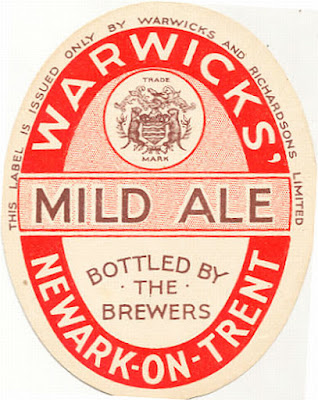It wasn’t just in London that Brown Ale was on the rise between the wars. The style was popular enough to appear in pretty much every brewery’s range. Though there was a considerable diversity in terms of strength and colour.
Rather fewer provincial examples were around the 1042º average OG of all beer. And there examples that are much weaker than London examples, some even under 1030º. In the case of Adnams, I know exactly why their Brown Ale was so weak. Like most smaller breweries, their Brown Ale was a tweaked version of their Mild. As that beer was piss weak, it followed that their Brown Ale would be, too.
One easily identifiable regional trend is in the Northeast. The two examples from there – Newcastle Brown and Vaux Double Maxim are notable for being both stronger and paler than most examples of the style. 50 and 62 are pretty low values for a Brown Ale. I’d expect a minimum of 80. Their gravities are both over 1050º which was unusual, but not totally unknown, in other parts of the country.
My guess is that all the ones stronger than Best Mild (around 1040-1043º) were their own separate brew and not based on a Mild Ale. For the simple reason that Mild didn’t usually get any stronger than that in the 1930s.
Note how common the name Nut Brown was. It has absolutely nothing to do with nuts or even with the flavour of the beer. I suspect that this Christmas carol is the source of the phrase. I've seen it in so many 19th-century collections of songs that it must have been very well known:
The nut-brown ale, the nut-brown ale,
Puts downe all drinke when it is stale,
The toast, the nut-meg, and the ginger,
Will make a sighing man a singer.
Ale gives a buffet in the head,
But ginger under proppes the brayne;
When ale would strike a strong man dead,
Then nut-megge tempers it againe,
The nut-brown ale, the nut-brown ale,
Puts downe all drinke when it is stale.
"Christmas Carols, ancient & modern" by William Sandys, 1833, page lxiv.
I'm not sure of its exact date but, judging by the language and spelling, it's no later than the 17th century and possibly 16th century.
In the 19th century, the phrase “nut brown ale” was regularly used to conjure up nostalgic images of the good beer of the past or to describe beer served at feasts. It was not a specific kind of beer, simply a florid description of celebratory beer.
| Provincial Brown Ale before WW II |
| Year |
Brewer |
Beer |
Price
per pint (d) |
OG |
FG |
ABV |
App.
Atten-uation |
colour |
| 1936 |
Birkenhead |
Nut Brown Ale |
6 |
1038.6 |
1010.5 |
3.64 |
72.80% |
|
| 1938 |
Eldridge Pope |
Dorset Brown Ale |
8 |
1038.2 |
1009.5 |
3.72 |
75.13% |
90 |
| 1938 |
Fremlin |
Brown Ale |
7 |
1041.8 |
1012.8 |
3.76 |
69.38% |
|
| 1938 |
Green |
Lutonian Nut Brown
Ale |
6 |
1028.3 |
1003.8 |
3.19 |
86.57% |
|
| 1932 |
Hoskins |
City Brown Ale |
6 |
1036.6 |
1009.7 |
3.49 |
73.50% |
|
| 1932 |
Ind Coope |
Nut Brown Ale |
7 |
1037 |
1008.2 |
3.74 |
77.84% |
|
| 1937 |
Mew Langton |
Brown Ale |
|
1048 |
1012.8 |
4.57 |
73.33% |
|
| 1933 |
Morgans |
SK Brown Ale |
10 |
1042 |
1012.4 |
3.83 |
70.48% |
|
| 1931 |
Newcastle Breweries |
Brown Ale |
|
1056 |
1014 |
5.46 |
75.00% |
62 |
| 1932 |
Northampton |
Brown Ale |
|
1038 |
1009.8 |
3.66 |
74.21% |
|
| 1938 |
Read |
Nut Brown Ale |
|
1030.5 |
1007.6 |
2.97 |
75.08% |
85 |
| 1935 |
Samuel Smith |
Taddy Nut Brown |
|
1042.1 |
1011.9 |
3.91 |
71.73% |
|
| 1938 |
Simonds |
Brown Ale |
|
1031.6 |
1008.2 |
3.03 |
74.05% |
130 |
| 1934 |
Adnams |
Brown Ale |
|
1031.5 |
|
|
|
|
| 1932 |
Tennant |
Nut Brown |
|
1032 |
1008.9 |
2.99 |
72.19% |
|
| 1938 |
Tollemache |
Brown Ale |
8 |
1044.9 |
1008.9 |
4.69 |
80.18% |
80 |
| 1938 |
Unwin |
Darker Brown |
|
1040.8 |
1007 |
4.40 |
82.84% |
105 |
| 1938 |
Vaux |
Double Maxim Ale |
|
1053.2 |
1009.3 |
5.73 |
82.52% |
50 |
| 1932 |
Ward |
Nut Brown |
|
1035 |
1007.6 |
3.56 |
78.29% |
|
|
Average |
|
7.25 |
1039.3 |
1009.6 |
3.91 |
0.76 |
86.0 |
| Sources: |
| Whitbread Gravity book held at the London Metropolitan
Archives, document number LMA/4453/D/02/001. |
| Younger, Wm. & Co Gravity Book document WY/6/1/1/19 held
at the Scottish Brewing Archive |
| Truman Gravity Book held at the London Metropolitan Archives,
document number B/THB/C/252. |
























































































